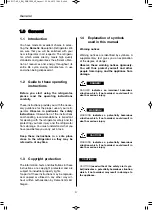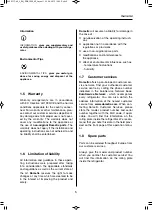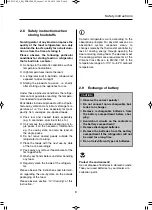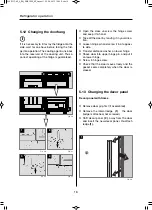
17
Refrigerator operation
5.9.4 Making ice cubes
Ice cubes are best frozen overnight. At night,
the refrigerator has less work to do and the
unit has more reserves.
1. Fill the ice cube tray
with drinking water.
2. Place the ice cube
tray in the freezer
compartment.
Fig. 23
Fig. 22
Only use drinking water!
WARNING!
5.10 Shutting off the refrigerator
n
Set energy selector switch
(1)
to position
"OFF"
. The appliance is switched off.
n
If the refrigerator is to be taken out of ser-
vice for an extended period of time, close
the onboard shut-off valve and the cylinder
valve .
n
Leave the door open. It shall be slightly ajar.
This is to prevent mould from forming
inside the appliance.
n
Release the locking mechanism of the door
lock by pushing it and shift it to the front. If
the door is shut in this position, a small gap
is nevertheless kept open to prevent forma-
tion of mildew.
Fig. 24
Fig. 25
1
OFF
OFF
5.11 Defrosting
As time goes by, frost builds up on the fins
inside the refrigerator. A layer of frost thicker
on one side may occur and does not represent
a malfunction. When this layer of frost is about
0.118 inches (3 mm) thick, the refrigerator
should be defrosted.
n
Switch off the refrigerator, as described in
section
5.10 Shutting of the refrigerator.
n
Remove all food and the ice cube tray.
n
Leave the rfrigerator door open to allow air
to enter and to prevent formation of mildew.
n
After defrosting (freezer compartment and
fins free of frost), wipe both cooling com-
partments dry with a cloth.
Note
: Water thawing in the main compartment
of the refrigerator runs into an appropriate
container at the back of the refrigerator. From
there, the water evaporates.
The layer of ice must never be removed
forcibly, nor may defrosting be accelera-
ted using a heat source!
CAUTION!
Fig. 26
Fig. 27
1
2
Fig. 28
2
normal position
out of operation
289 0317-60_2_EN_RGE3000_N1_Layout 1 25.06.2013 12:52 Seite 17
















































